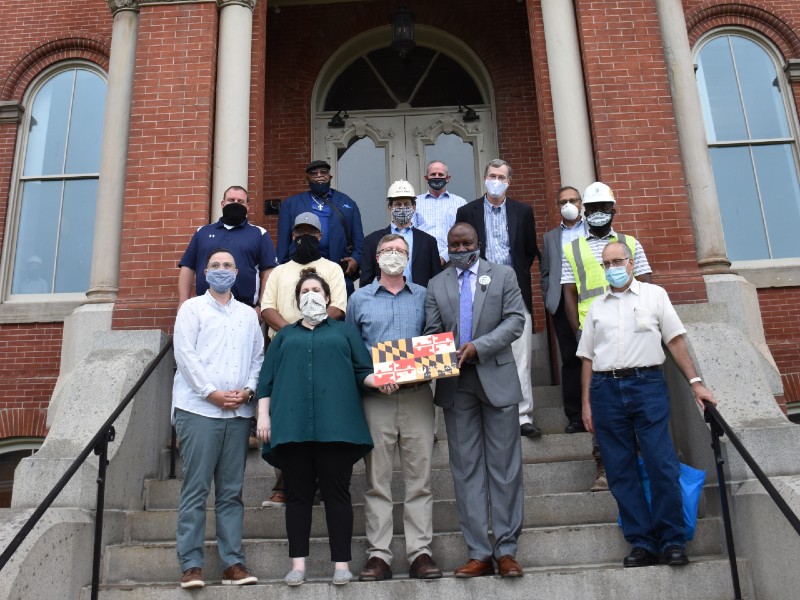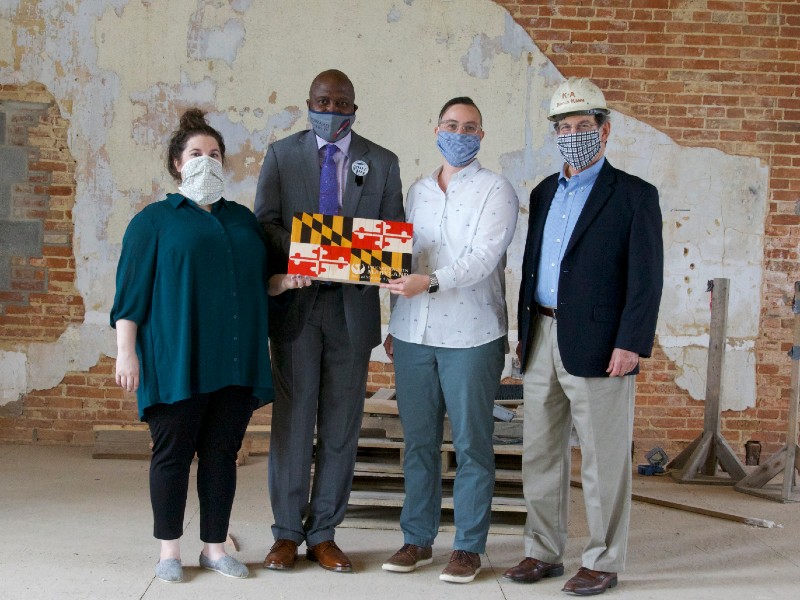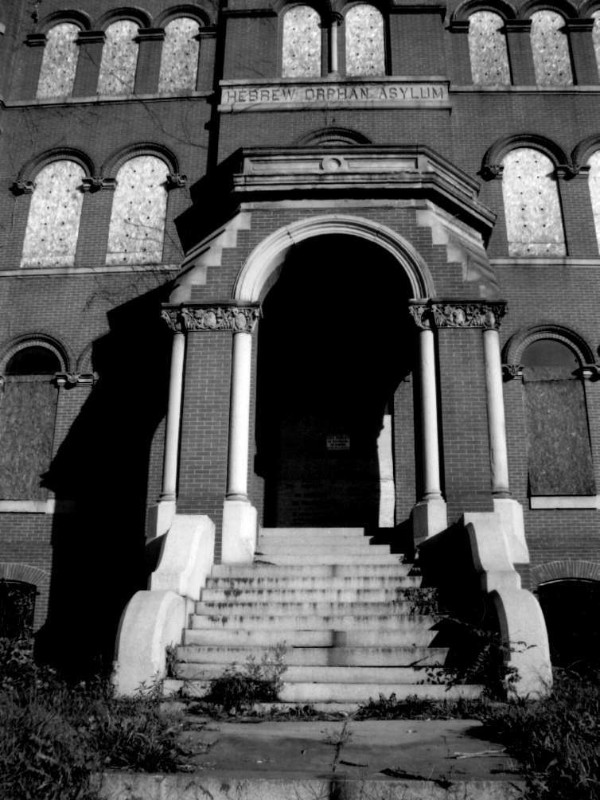Preservation Maryland recently presented the organizations 2020 Best of Maryland “The Phoenix Award” to the project team and community stakeholders of the large-scale renovation project at the Center For Health Care and Healthy Living at the Baltimore Hebrew Orphan Asylum in the Coppin Heights/Rosemont neighborhood of West Baltimore.
The Center for Health Care and Healthy Living will soon be 100% occupied by the Baltimore City Health Department and Behavioral Health System Baltimore. The new space will be specifically used for the Maryland Crisis Stabilization Center where patients will receive short-term medical attention and sobering services for those addicted to drugs or alcohol with additional space for lease to other medical service providers. To attend to the immediate needs of the neighborhood, a Covid-19 call tracing center will be opening on the upper floors in the coming weeks.
- Front steps of the Hebrew Orphan Asylum. Photo by Baltimore Heritage for the Maryland Historical Trust.
- Coppin Heights Community Development Corporation and Baltimore Heritage at the Hebrew Orphan Asylum, 2009.
The successful $17 million restoration of the ca. 1876 Hebrew Orphan Asylum stretched out over 16 years and utilized Maryland Sustainable Communities tax credits, National Park Service historic tax credits, and other incentives. Over that time, today’s inspiring renovation and reuse was not a foregone conclusion – the building was almost lost to history after years of abandonment and calls for demolition. However, strong advocacy, led by Baltimore Heritage, Inc., brought in voices from community stakeholders and critical new partners. The combination of a signature vacant building and the desperate need for medical options created a powerful opportunity for reuse. Together, Coppin Heights Community Development Corporation and Cross Street Partners brought the Baltimore City Health Department to the table.
By the time the preservation project began in earnest in 2011, the main roof had collapsed and the wood frame structure failed. KANN Partners now joined with lead firm Waldon Studio Architects, completed a conditions assessment with a grant from Preservation Maryland and the Maryland Historical Trust as a first step in developing a stabilization and reconstruction plan. After several years of intense effort, a full rehabilitation approach was forged. Bricks from collapsed walls were carefully salvaged and used to rebuild. Out of 127 windows, 75% of the frames and molding were restored and the remainder were reconstructed referencing historic photographs. The missing central monumental staircase and octagonal skylight were researched and redesigned as a contemporary design with historic overtures. Throughout the project, the team was thrown many curve-balls, including the effects of Baltimore’s first earthquake in 100 years.
- Southway Builders at Hebrew Orphan Asylum rehabilitation project in Baltimore, MD.
 Katherine Good of Waldon Studio Architects, reflects on the accomplishments of the project team, “This challenging project and unique building is once again ready to serve the community – not only as a healthcare center but as a preservation marvel.” Additional project partners include but are not limited to, Ballard Spahr; Baltimore City Health Department; Baltimore Heritage, Inc.;, Behavioral Health System of Baltimore,; Coppin Heights Community Development Corporation; Cross Street Partners; Reinvestment Fund; KANN Partners; Southway Builders/C.L. McCoy Joint Venture, and Waldon Studio Architects.
Katherine Good of Waldon Studio Architects, reflects on the accomplishments of the project team, “This challenging project and unique building is once again ready to serve the community – not only as a healthcare center but as a preservation marvel.” Additional project partners include but are not limited to, Ballard Spahr; Baltimore City Health Department; Baltimore Heritage, Inc.;, Behavioral Health System of Baltimore,; Coppin Heights Community Development Corporation; Cross Street Partners; Reinvestment Fund; KANN Partners; Southway Builders/C.L. McCoy Joint Venture, and Waldon Studio Architects.
 In accepting “The Phoenix Award” from Preservation Maryland, Dr. Gary D. Rodwell, Executive Director, Coppin Heights Community Development Corporation, stated, “This project is the culmination of a decade of work…for over a year before undertaking the project, Coppin Heights CDC carefully gathered input from local residents, and they told us they wanted a health care facility. What you see today is the outcome of a unique combination of the strong support of the community, Baltimore City government, the State of Maryland, local foundations, and our development and construction partners. Each component of this coalition was essential to making the Center for Health Care and Healthy Living a reality.” Continuing, “I would like to thank Lieutenant Governor Boyd Rutherford and the Maryland Department of Housing and Community Development for their financial support. I would also like to acknowledge the support of the Harry and Jeanette Weinberg Foundation, the Baltimore City Health Department, and many others. Finally, I thank the Board of the CDC, who fought tirelessly to ensure that this long-term health care asset not only serves the community but also, through the ownership interest of the CDC, truly belongs to it.”
In accepting “The Phoenix Award” from Preservation Maryland, Dr. Gary D. Rodwell, Executive Director, Coppin Heights Community Development Corporation, stated, “This project is the culmination of a decade of work…for over a year before undertaking the project, Coppin Heights CDC carefully gathered input from local residents, and they told us they wanted a health care facility. What you see today is the outcome of a unique combination of the strong support of the community, Baltimore City government, the State of Maryland, local foundations, and our development and construction partners. Each component of this coalition was essential to making the Center for Health Care and Healthy Living a reality.” Continuing, “I would like to thank Lieutenant Governor Boyd Rutherford and the Maryland Department of Housing and Community Development for their financial support. I would also like to acknowledge the support of the Harry and Jeanette Weinberg Foundation, the Baltimore City Health Department, and many others. Finally, I thank the Board of the CDC, who fought tirelessly to ensure that this long-term health care asset not only serves the community but also, through the ownership interest of the CDC, truly belongs to it.”

Project team accepting The Phoenix Award at the Hebrew Orphan Asylum, August 2020.
Preservation Maryland is honored to highlight and elevate the work of the Center for Health Care and Healthy Living partners with this year’s Best of Maryland “The Phoenix Award.” Executive Director Nicholas Redding remarked, “The creative reimagining and hard work to bring the Hebrew Orphan Asylum back from the brink of being lost to history not only saved a remarkable architectural gem but reference the original intent of the building – to help those in need – and is continuing that long commitment to our fellow Marylanders in need. I cannot think of a more deserving and appropriate project for this year’s “The Phoenix Award” than the project team of the Maryland Center for Health Care and Healthy Living.”
If you or someone you know is in need of addiction treatment, visit Behavioral Health System Baltimore online at: bhsbaltimore.org.
Since 1931, Preservation Maryland has worked to protect and promote Maryland’s history and heritage. As a non-profit organization, we work with partners across the state and country to accomplish this important mission through advocacy, funding, and outreach. Preservation Maryland’s major programs include the Maryland Redevelopment Revolving Fund, Campaign for Historic Trades, Smart Growth Maryland, and on-going public history, preservation, and archaeology project across the Old Line State. Website: presmd.org.
Waldon Studio Architects was founded to serve and strengthen the community through creative design. The firm believes that architecture has the power to create positive change, enrich lives, and elevate purpose. Our work embraces the individualism of those we serve, reflecting their vision and culture. Creative compassion for our clients has enabled WSA to produce award-winning architecture, receiving local and national recognition. Website: waldonstudio.com.
The Coppin Heights Community Development Corporation is a not-for-profit organization established in 1995 by Coppin State University to advance the broader community improvement/neighborhood revitalization agenda for the Greater Coppin Heights/Rosemont Community in West Baltimore, Maryland. The mission of CDC is to be a catalyst for suitable and affordable housing for low to moderate-income residents and to stimulate economic development within neighborhoods immediately adjacent to University through the establishment of social, economic, educational and affordable housing development initiatives that collectively increase the stability and sustainability of our community. Website: coppinheightscdc.com.











